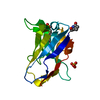+ Open data
Open data
- Basic information
Basic information
| Entry | Database: PDB / ID: 3jbf | ||||||
|---|---|---|---|---|---|---|---|
| Title | Complex of poliovirus with VHH PVSP19B | ||||||
 Components Components |
| ||||||
 Keywords Keywords | VIRUS/IMMUNE SYSTEM /  poliovirus / poliovirus /  nanobodies / VHH / nanobodies / VHH /  neutralizing antibodies / VIRUS-IMMUNE SYSTEM complex neutralizing antibodies / VIRUS-IMMUNE SYSTEM complex | ||||||
| Function / homology |  Function and homology information Function and homology informationsymbiont-mediated suppression of host translation initiation / symbiont-mediated suppression of host cytoplasmic pattern recognition receptor signaling pathway via inhibition of MDA-5 activity / symbiont-mediated suppression of host cytoplasmic pattern recognition receptor signaling pathway via inhibition of RIG-I activity /  picornain 2A / symbiont-mediated suppression of host mRNA export from nucleus / symbiont-mediated suppression of host cytoplasmic pattern recognition receptor signaling pathway via inhibition of MAVS activity / symbiont genome entry into host cell via pore formation in plasma membrane / picornain 2A / symbiont-mediated suppression of host mRNA export from nucleus / symbiont-mediated suppression of host cytoplasmic pattern recognition receptor signaling pathway via inhibition of MAVS activity / symbiont genome entry into host cell via pore formation in plasma membrane /  picornain 3C / ribonucleoside triphosphate phosphatase activity / T=pseudo3 icosahedral viral capsid ...symbiont-mediated suppression of host translation initiation / symbiont-mediated suppression of host cytoplasmic pattern recognition receptor signaling pathway via inhibition of MDA-5 activity / symbiont-mediated suppression of host cytoplasmic pattern recognition receptor signaling pathway via inhibition of RIG-I activity / picornain 3C / ribonucleoside triphosphate phosphatase activity / T=pseudo3 icosahedral viral capsid ...symbiont-mediated suppression of host translation initiation / symbiont-mediated suppression of host cytoplasmic pattern recognition receptor signaling pathway via inhibition of MDA-5 activity / symbiont-mediated suppression of host cytoplasmic pattern recognition receptor signaling pathway via inhibition of RIG-I activity /  picornain 2A / symbiont-mediated suppression of host mRNA export from nucleus / symbiont-mediated suppression of host cytoplasmic pattern recognition receptor signaling pathway via inhibition of MAVS activity / symbiont genome entry into host cell via pore formation in plasma membrane / picornain 2A / symbiont-mediated suppression of host mRNA export from nucleus / symbiont-mediated suppression of host cytoplasmic pattern recognition receptor signaling pathway via inhibition of MAVS activity / symbiont genome entry into host cell via pore formation in plasma membrane /  picornain 3C / ribonucleoside triphosphate phosphatase activity / T=pseudo3 icosahedral viral capsid / host cell cytoplasmic vesicle membrane / endocytosis involved in viral entry into host cell / picornain 3C / ribonucleoside triphosphate phosphatase activity / T=pseudo3 icosahedral viral capsid / host cell cytoplasmic vesicle membrane / endocytosis involved in viral entry into host cell /  : / nucleoside-triphosphate phosphatase / protein complex oligomerization / monoatomic ion channel activity / : / nucleoside-triphosphate phosphatase / protein complex oligomerization / monoatomic ion channel activity /  RNA helicase activity / induction by virus of host autophagy / RNA helicase activity / induction by virus of host autophagy /  RNA-directed RNA polymerase / symbiont-mediated suppression of host gene expression / viral RNA genome replication / cysteine-type endopeptidase activity / RNA-directed RNA polymerase / symbiont-mediated suppression of host gene expression / viral RNA genome replication / cysteine-type endopeptidase activity /  RNA-dependent RNA polymerase activity / DNA-templated transcription / host cell nucleus / structural molecule activity / virion attachment to host cell / RNA-dependent RNA polymerase activity / DNA-templated transcription / host cell nucleus / structural molecule activity / virion attachment to host cell /  proteolysis / proteolysis /  RNA binding / RNA binding /  ATP binding / ATP binding /  membrane / membrane /  metal ion binding metal ion bindingSimilarity search - Function | ||||||
| Biological species |   Camelus dromedarius (Arabian camel) Camelus dromedarius (Arabian camel)   Human poliovirus 1 Mahoney Human poliovirus 1 Mahoney | ||||||
| Method |  ELECTRON MICROSCOPY / ELECTRON MICROSCOPY /  single particle reconstruction / single particle reconstruction /  cryo EM / Resolution: 4.8 Å cryo EM / Resolution: 4.8 Å | ||||||
 Authors Authors | Strauss, M. / Schotte, L. / Thys, B. / Filman, D.J. / Hogle, J.M. | ||||||
 Citation Citation |  Journal: J Virol / Year: 2016 Journal: J Virol / Year: 2016Title: Five of Five VHHs Neutralizing Poliovirus Bind the Receptor-Binding Site. Authors: Mike Strauss / Lise Schotte / Bert Thys / David J Filman / James M Hogle /   Abstract: Nanobodies, or VHHs, that recognize poliovirus type 1 have previously been selected and characterized as candidates for antiviral agents or reagents for standardization of vaccine quality control. In ...Nanobodies, or VHHs, that recognize poliovirus type 1 have previously been selected and characterized as candidates for antiviral agents or reagents for standardization of vaccine quality control. In this study, we present high-resolution cryo-electron microscopy reconstructions of poliovirus with five neutralizing VHHs. All VHHs bind the capsid in the canyon at sites that extensively overlap the poliovirus receptor-binding site. In contrast, the interaction involves a unique (and surprisingly extensive) surface for each of the five VHHs. Five regions of the capsid were found to participate in binding with all five VHHs. Four of these five regions are known to alter during the expansion of the capsid associated with viral entry. Interestingly, binding of one of the VHHs, PVSS21E, resulted in significant changes of the capsid structure and thus seems to trap the virus in an early stage of expansion. IMPORTANCE: We describe the cryo-electron microscopy structures of complexes of five neutralizing VHHs with the Mahoney strain of type 1 poliovirus at resolutions ranging from 3.8 to 6.3Å. All five ...IMPORTANCE: We describe the cryo-electron microscopy structures of complexes of five neutralizing VHHs with the Mahoney strain of type 1 poliovirus at resolutions ranging from 3.8 to 6.3Å. All five VHHs bind deep in the virus canyon at similar sites that overlap extensively with the binding site for the receptor (CD155). The binding surfaces on the VHHs are surprisingly extensive, but despite the use of similar binding surfaces on the virus, the binding surface on the VHHs is unique for each VHH. In four of the five complexes, the virus remains essentially unchanged, but for the fifth there are significant changes reminiscent of but smaller in magnitude than the changes associated with cell entry, suggesting that this VHH traps the virus in a previously undescribed early intermediate state. The neutralizing mechanisms of the VHHs and their potential use as quality control agents for the end game of poliovirus eradication are discussed. | ||||||
| History |
|
- Structure visualization
Structure visualization
| Movie |
 Movie viewer Movie viewer |
|---|---|
| Structure viewer | Molecule:  Molmil Molmil Jmol/JSmol Jmol/JSmol |
- Downloads & links
Downloads & links
- Download
Download
| PDBx/mmCIF format |  3jbf.cif.gz 3jbf.cif.gz | 178.6 KB | Display |  PDBx/mmCIF format PDBx/mmCIF format |
|---|---|---|---|---|
| PDB format |  pdb3jbf.ent.gz pdb3jbf.ent.gz | 138.6 KB | Display |  PDB format PDB format |
| PDBx/mmJSON format |  3jbf.json.gz 3jbf.json.gz | Tree view |  PDBx/mmJSON format PDBx/mmJSON format | |
| Others |  Other downloads Other downloads |
-Validation report
| Arichive directory |  https://data.pdbj.org/pub/pdb/validation_reports/jb/3jbf https://data.pdbj.org/pub/pdb/validation_reports/jb/3jbf ftp://data.pdbj.org/pub/pdb/validation_reports/jb/3jbf ftp://data.pdbj.org/pub/pdb/validation_reports/jb/3jbf | HTTPS FTP |
|---|
-Related structure data
| Related structure data |  6434MC  6433C  6435C  3jbcC  3jbdC  3jbeC  3jbgC M: map data used to model this data C: citing same article ( |
|---|---|
| Similar structure data |
- Links
Links
- Assembly
Assembly
| Deposited unit | 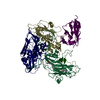
|
|---|---|
| 1 | x 60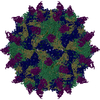
|
| 2 |
|
| 3 | x 5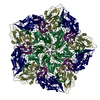
|
| 4 | x 6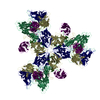
|
| 5 | 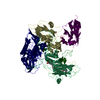
|
| Symmetry | Point symmetry: (Schoenflies symbol : I (icosahedral : I (icosahedral )) )) |
- Components
Components
-Capsid protein ... , 4 types, 4 molecules 1234
| #1: Protein |  / P1D / Virion protein 1 / P1D / Virion protein 1Mass: 33488.613 Da / Num. of mol.: 1 / Fragment: UNP residues 580-881 / Source method: isolated from a natural source / Source: (natural)    Human poliovirus 1 Mahoney / Strain: Mahoney / References: UniProt: P03300 Human poliovirus 1 Mahoney / Strain: Mahoney / References: UniProt: P03300 |
|---|---|
| #2: Protein |  / P1B / Virion protein 2 / P1B / Virion protein 2Mass: 30075.783 Da / Num. of mol.: 1 / Fragment: UNP residues 70-341 / Source method: isolated from a natural source / Source: (natural)    Human poliovirus 1 Mahoney / Strain: Mahoney / References: UniProt: P03300 Human poliovirus 1 Mahoney / Strain: Mahoney / References: UniProt: P03300 |
| #3: Protein |  / P1C / Virion protein 3 / P1C / Virion protein 3Mass: 26419.352 Da / Num. of mol.: 1 / Fragment: UNP residues 342-578 / Source method: isolated from a natural source / Source: (natural)    Human poliovirus 1 Mahoney / Strain: Mahoney / References: UniProt: P03300 Human poliovirus 1 Mahoney / Strain: Mahoney / References: UniProt: P03300 |
| #4: Protein |  / P1A / Virion protein 4 / P1A / Virion protein 4Mass: 7603.405 Da / Num. of mol.: 1 / Fragment: UNP residues 2-69 / Source method: isolated from a natural source / Source: (natural)    Human poliovirus 1 Mahoney / Strain: Mahoney / References: UniProt: P03300 Human poliovirus 1 Mahoney / Strain: Mahoney / References: UniProt: P03300 |
-Antibody / Non-polymers , 2 types, 2 molecules 7

| #5: Antibody | Mass: 14064.470 Da / Num. of mol.: 1 Source method: isolated from a genetically manipulated source Source: (gene. exp.)   Camelus dromedarius (Arabian camel) / Plasmid details: pHEN6(c) / Production host: Camelus dromedarius (Arabian camel) / Plasmid details: pHEN6(c) / Production host:   Escherichia coli (E. coli) / Strain (production host): WK6 Escherichia coli (E. coli) / Strain (production host): WK6 |
|---|---|
| #6: Chemical | ChemComp-PLM /  Palmitic acid Palmitic acid |
-Experimental details
-Experiment
| Experiment | Method:  ELECTRON MICROSCOPY ELECTRON MICROSCOPY |
|---|---|
| EM experiment | Aggregation state: PARTICLE / 3D reconstruction method:  single particle reconstruction single particle reconstruction |
- Sample preparation
Sample preparation
| Component |
| ||||||||||||||||||||
|---|---|---|---|---|---|---|---|---|---|---|---|---|---|---|---|---|---|---|---|---|---|
| Molecular weight | Value: 9 MDa / Experimental value: NO | ||||||||||||||||||||
| Details of virus | Empty: NO / Enveloped: NO / Host category: VERTEBRATES / Isolate: SEROTYPE / Type: VIRION | ||||||||||||||||||||
| Natural host | Organism: Homo sapiens | ||||||||||||||||||||
| Buffer solution | Name: 145 mM NaCl, 50 mM Na2HPO4.12H2O / pH: 7.4 / Details: 145 mM NaCl, 50 mM Na2HPO4.12H2O | ||||||||||||||||||||
| Specimen | Conc.: 1 mg/ml / Embedding applied: NO / Shadowing applied: NO / Staining applied : NO / Vitrification applied : NO / Vitrification applied : YES : YES | ||||||||||||||||||||
| Specimen support | Details: C-flat 1.2/1.3 | ||||||||||||||||||||
Vitrification | Instrument: HOMEMADE PLUNGER / Cryogen name: ETHANE / Temp: 154 K Details: Blotted for 4 seconds before plunging into liquid ethane (homemade plunger). Method: 4 second blot |
- Electron microscopy imaging
Electron microscopy imaging
| Experimental equipment |  Model: Tecnai Polara / Image courtesy: FEI Company |
|---|---|
| Microscopy | Model: FEI POLARA 300 / Date: Nov 27, 2013 / Details: Gatan K2 operated in Super-resolution mode |
| Electron gun | Electron source : :  FIELD EMISSION GUN / Accelerating voltage: 300 kV / Illumination mode: FLOOD BEAM / Electron beam tilt params: 0 FIELD EMISSION GUN / Accelerating voltage: 300 kV / Illumination mode: FLOOD BEAM / Electron beam tilt params: 0 |
| Electron lens | Mode: BRIGHT FIELD Bright-field microscopy / Nominal magnification: 23000 X / Calibrated magnification: 25381 X / Nominal defocus max: -4000 nm / Nominal defocus min: -1400 nm / Cs Bright-field microscopy / Nominal magnification: 23000 X / Calibrated magnification: 25381 X / Nominal defocus max: -4000 nm / Nominal defocus min: -1400 nm / Cs : 2.26 mm : 2.26 mm |
| Specimen holder | Specimen holder model: OTHER / Specimen holder type: Polara holder / Temperature: 80 K / Temperature (max): 110 K / Temperature (min): 80 K |
| Image recording | Electron dose: 25 e/Å2 / Film or detector model: GATAN K2 (4k x 4k) |
| Image scans | Num. digital images: 300 |
- Processing
Processing
| EM software |
| |||||||||||||||||||||||||||||||||||||||||||||
|---|---|---|---|---|---|---|---|---|---|---|---|---|---|---|---|---|---|---|---|---|---|---|---|---|---|---|---|---|---|---|---|---|---|---|---|---|---|---|---|---|---|---|---|---|---|---|
CTF correction | Details: per particle | |||||||||||||||||||||||||||||||||||||||||||||
| Symmetry | Point symmetry : I (icosahedral : I (icosahedral ) ) | |||||||||||||||||||||||||||||||||||||||||||||
3D reconstruction | Resolution: 4.8 Å / Resolution method: FSC 0.143 CUT-OFF / Num. of particles: 18009 / Nominal pixel size: 0.985 Å / Actual pixel size: 0.985 Å Details: (Single particle details: The particles were processed using Frealign.) (Single particle--Applied symmetry: I) Symmetry type: POINT | |||||||||||||||||||||||||||||||||||||||||||||
| Atomic model building | Protocol: FLEXIBLE FIT / Space: RECIPROCAL Target criteria: ML agreement with Fourier amplitudes and phases Details: REFINEMENT PROTOCOL--flexible DETAILS--Using stereochemically and icosahedrally restrained maximum likelihood refinement in REFMAC5, a representative subset of the full atomic model with all ...Details: REFINEMENT PROTOCOL--flexible DETAILS--Using stereochemically and icosahedrally restrained maximum likelihood refinement in REFMAC5, a representative subset of the full atomic model with all neighbors present was built and refined to fit the corresponding subset of the experimental map. Portions of the model whose density resembled a structural homolog were identified and restrained to agree with the homolog. Detailed atomic models were constructed in areas of difference wherever the resolution of the map permitted. The Fourier-amplitude-weighted average cosine of the phase discrepancy was tracked. | |||||||||||||||||||||||||||||||||||||||||||||
| Atomic model building | PDB-ID: 1I3U | |||||||||||||||||||||||||||||||||||||||||||||
| Refinement | Resolution: 4.6→95.15 Å / Cor.coef. Fo:Fc: 0.702 / SU B: 110.77 / SU ML: 1.342 / σ(F): 0 / ESU R: 1.58 Stereochemistry target values: MAXIMUM LIKELIHOOD WITH PHASES
| |||||||||||||||||||||||||||||||||||||||||||||
| Solvent computation | Solvent model: NONE | |||||||||||||||||||||||||||||||||||||||||||||
| Displacement parameters | Biso max: 50 Å2 / Biso mean: 24.734 Å2 / Biso min: 10 Å2
| |||||||||||||||||||||||||||||||||||||||||||||
| Refinement step | Cycle: LAST / Resolution: 4.6→95.15 Å
| |||||||||||||||||||||||||||||||||||||||||||||
| Refine LS restraints |
| |||||||||||||||||||||||||||||||||||||||||||||
| LS refinement shell | Resolution: 4.6→4.848 Å / Total num. of bins used: 10
|
 Movie
Movie Controller
Controller





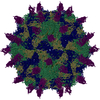
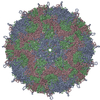
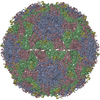
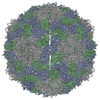
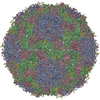
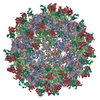
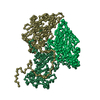
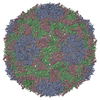
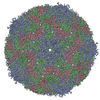
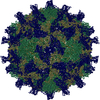
 PDBj
PDBj











